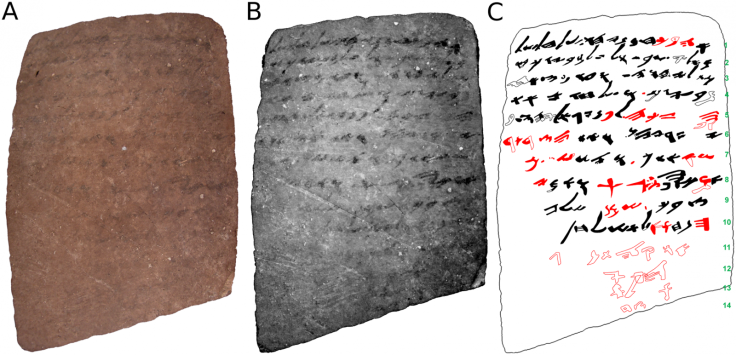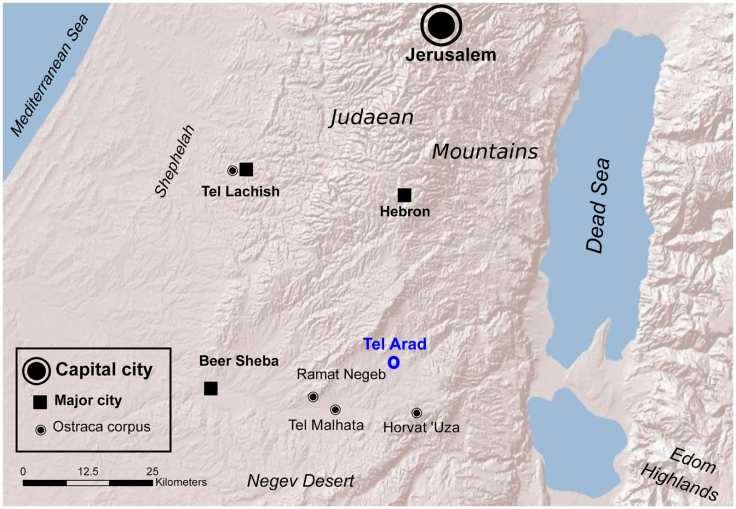Israel: 'Invisible' Hebrew text tells of life in the Kingdom of Judah
Multispectral imaging can help reveal long-lost ancient texts.

Using an innovative imaging technique, archaeologists have revealed ancient Hebrew inscriptions on a 2,600-year-old piece of pottery, which had remained invisible to the naked eye until now.
Known as an ostraca, the artefact dates back to Biblical times, and was found in the desert fortress of Arad (Israel), in what was once the Kingdom of Judah. The final years of the Kingdom of Judah described in the Hebrew Bible ended with the destruction of Jerusalem by the Babylonian king Nebuchadnezzar in 586 BCE.
These years were characterised by intense literary activity, with the most important texts – of political and religious nature – probably inscribed on papyrus. However, few have survived the passing of time.
As such, most of the texts that have been unearthed and analysed by archaeologists consist of Hebrew ink inscriptions dealing with daily life topics, and written on clay and ceramic pottery sherds – the so-called ostraca.
"We do not really have any political or religious texts that are left today from that area, because we think that most of them were recorded on papyrus and have disappeared over the years in this climate. So all we can study are mundane issues recorded on ostraca with messages like "bring wine or bread to this military unit" or "dealing with the moving of troops", Shira Faigenbaum-Golovin, from Tel Aviv University, told IBTimes UK.
The secrets of the ostraca
The problem is that ostraca are often poorly preserved. Once unearthed, the text often fades rapidly. Depending on the type of clay used, the words can even be invisible, so archaeologists often struggle to decipher the messages carried by these artefacts.
In a study now published in the journal PLOS One, Faigenbaum-Golovin and colleagues designed a new protocol using multispectral imaging to study a number of ostraca dating back to around 600 BCE, towards the end days of the Kingdom of Judah.
What is multispectral imaging?
Multispectral imaging is the procedure used to observe an object using selected ranges of wavelengths in the electromagnetic spectrum that include and extend beyond the capabilities of the human eye.
It has often been used in archaeology, for example to study ancient papyrus (such as the dead sea scrolls) or ancient documents, but never to decipher the words inscribed on an ostraca.
One of these ostraca had been discovered more than 50 years ago at the Arad fortress, located in an arid desert. It had been displayed in an Israel museum ever since. While its front side - where lines of text appear - had been extensively studied, its reverse side was considered blank.
With their technique, the archaeologists showed that this was not the case. Three lines of text were revealed on the supposedly blank side thanks to multispectral imaging and four "new" lines appeared on the front side.
Overall, the text on the front and back of the ostraca appears to detail an exchange of supplies and silver between a man called Elyashiv, the quartermaster of the Arad fortress, and another one called Ḥananyahu - possibly his peer at Beer Sheba, located a day's walk to the west.
The message suggests the two men were on friendly terms, exchanging salutations and blessings ("I bless [you] by Yahweh") as well as requests for commodities such as silver, wine and oil.

These findings are valuable to archaeologists on a number of counts. First, they show the validity of using multispectral imaging to identify long-lost texts. Second, the words brought to light by the researchers provide an additional source for linguistic studies of ancient Hebrew and other Semitic languages.
Finally, while the content of the text is not surprising, it backs up what had been found before regarding the last years of the Kingdom of Judah.
Many more ostraca have been discovered at the fortress of Arad, and archaeologists have now access to more than 100 Hebrew inscriptions from that place and time, including the ones described in this study.
Set against the background of the stormy events in the final years before the fall of the Kingdom of Judah, the inscriptions provide extra-biblical evidence of how people and soldiers would have experienced these events, going on with their daily life as the supply of commodities to military units and movement of troops listed on the ostraca suggest.
"Because there are not so many inscriptions from this time period, every new line or words discovered can help linguists and be added to our dictionaries. Every letter is important, and using our new analysis, we building upon our knowledge to learn more about these people,"Faigenbaum-Golovin concluded.
© Copyright IBTimes 2024. All rights reserved.






